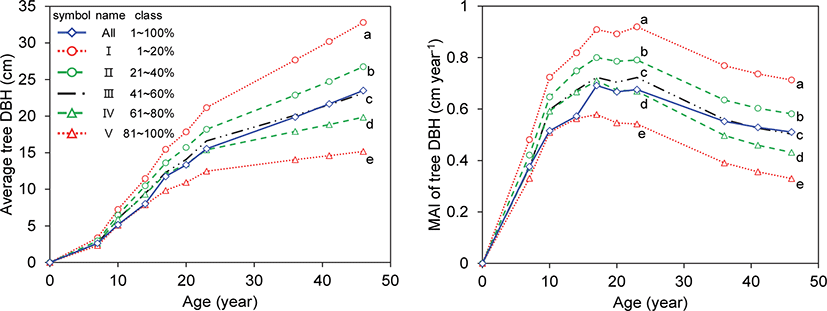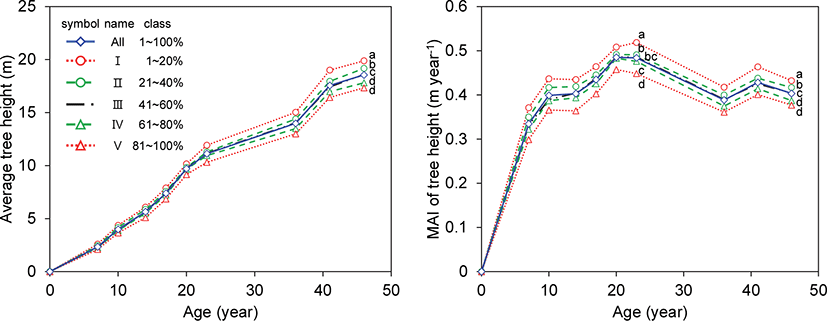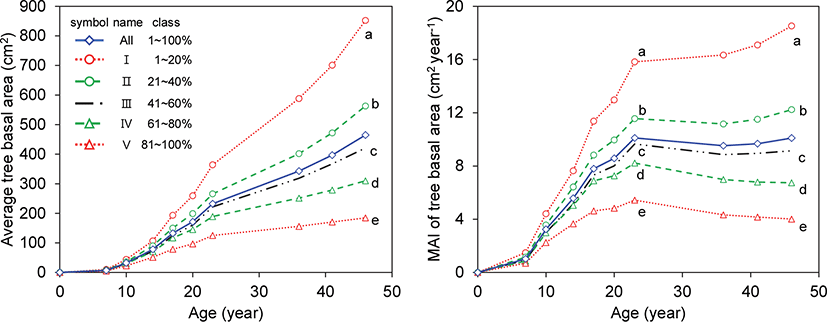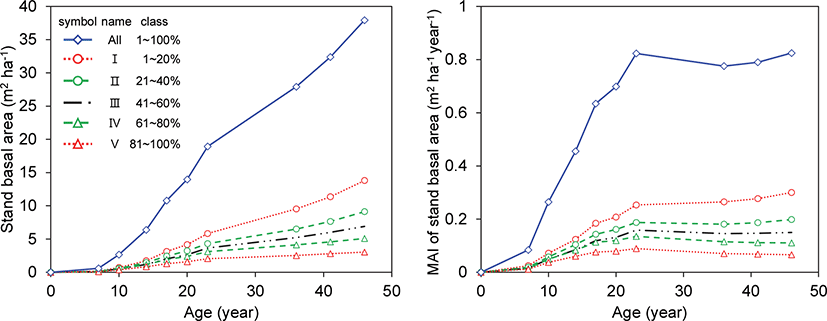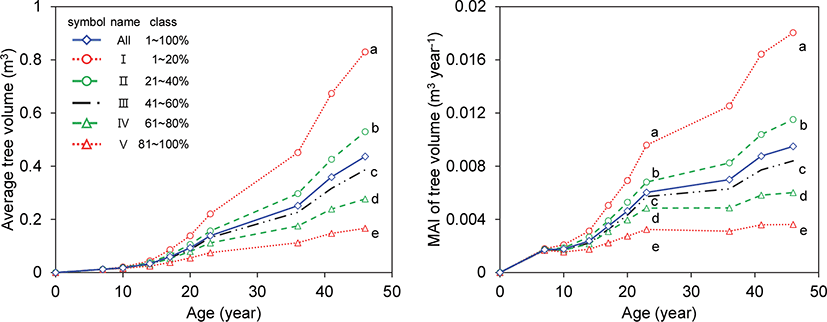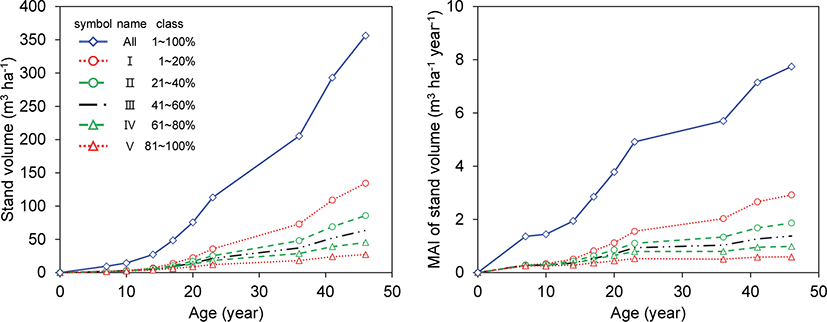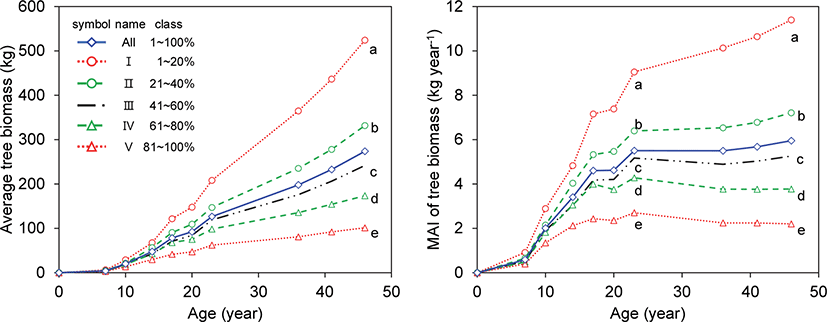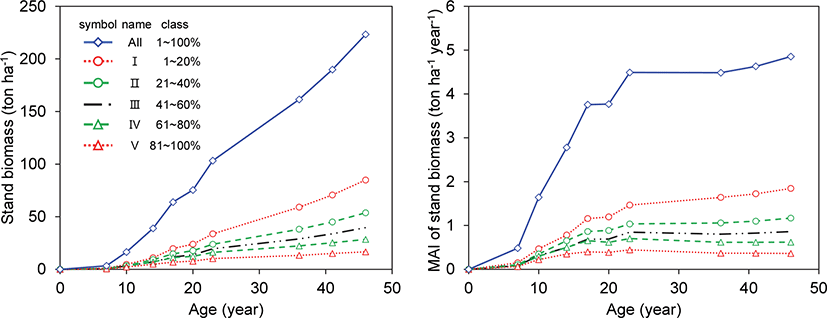Article
잣나무 인공림의 흉고직경 등급별 생장변화에 관한 연구
A Study on the Growth Change by DBH Class in Korean White Pine Plantations
Sunghoon Jung1
,
Yeongwan Seo2
,
Daesung Lee3
,
Jungkee Choi1,*
Author Information & Copyright ▼
1Division of Forest Science, Kangwon National University, Chuncheon 24341, Korea
2Institute of Forest Science, Kangwon National University, Chuncheon 24341, Korea
3Natural Resources Institute Finland (Luke), Latokartanonkaari 9, 00790 Helsinki, Finland
© Copyright 2022 Korean Society of Forest Science. This is an Open-Access article distributed under the terms of the
Creative Commons Attribution Non-Commercial License (http://creativecommons.org/licenses/by-nc/4.0/) which permits
unrestricted non-commercial use, distribution, and reproduction in any
medium, provided the original work is properly cited.
Received: Jul 08, 2021; Revised: Jan 31, 2022; Accepted: Feb 03, 2022
Published Online: Mar 31, 2022
요약
본 연구는 장기 모니터링 자료를 이용하여 우리나라 잣나무 인공림의 흉고직경, 수고, 흉고단면적, 재적, 바이오매스 생장변화를 파악하기 위해 수행되었다. 또한, 인자별 입목의 상대적 크기에 따른 생장을 비교하여 향후 인공림의 경급별 생산·수확을 위한 기초자료를 제공하고자 하였다. 이를 위해 흉고직경 기준 20%씩 총 5개의 등급인 Ⅰ등급(1~20%, 상위 20%), Ⅱ등급(21~40%), Ⅲ등급(41~60%), Ⅳ등급(61~80%), Ⅴ등급(81~100%, 하위 20%) 및 전체등급(0~100%)으로 구분하여 등급별 생장특성을 비교분석하였다. 본 연구에서는 39년간 9회 조사된 자료를 이용하여 총생장과 연평균생장량이 산출되었으며, 입목평균을 이용한 개체목 특성과 단위면적 ha당 산출값을 이용한 임분 특성이 분석되었다. 인자별 총생장 분석 결과, 흉고직경, 흉고단면적, 재적, 바이오매스는 시간이 경과할수록 등급 간 총생장의 차이가 증가하였으나, 수고생장의 차이는 지속적으로 증가하지 않았다. 연평균생장량 분석결과, 평균흉고직경의 Ⅰ등급 최대값은 23년생 때 0.92 cm·yr−1 로 관측되었으며, 전체등급의 최대값은 17년생 때 0.69 cm·yr−1로 파악되었다. 평균수고의 Ⅰ등급 연평균생장량은 23년생 때 0.52 m·yr−1로 최대였으며, 전체등급의 최대값은 20년생 때 0.49 m·yr−1로 파악되었다. 개체목 및 임분 단위의 흉고단면적, 재적, 바이오매스의 경우, 본 조사기간인 46년생까지 Ⅰ등급과 전체등급의 연평균생장량 최대값은 관측되지 않았다. 따라서 해당 인자들의 연평균생장량 최대값을 파악하기 위해서는 보다 장기간의 모니터링이 요구된다.
Abstract
In this study, growth changes of the diameter at breast height (DBH), height, basal area, volume, and biomass of Korean white pine (Pinus koraiensis Siebold & Zucc.) on a plantation were examined via long-term monitoring. In addition, this study was performed to provide the basic data for timber production in line with DBH class by comparing the growth of the relative DBH size. Growth characteristics according to DBH class were analyzed by categorizing trees into five classes based on sorted DBH rankings: class Ⅰ (1%–20%; upper 20%), class Ⅱ (21%–40%), class Ⅲ (41%–60%), class Ⅳ (61%–80%), class Ⅴ (81%–100%; lower 20%). A total class (0%–100%) was also used. Total increment and mean annual increment (MAI) were calculated using data from nine measurements taken over 39 years. Tree characteristics based on average values and stand characteristics based on unit area per hectare were examined. According to the total increments of variables, the differences in DBH, basal area, volume, and biomass among classes Ⅰ–Ⅴ increased over time, whereas the height difference did not continually increase. According to MAI, the maximum DBH value was 0.92 cm·yr−1 at age 23 in class Ⅰ, whereas the maximum value in all trees was 0.69 cm·yr−1 at age 17. The maximum value of height MAI for class Ⅰ was 0.52 m·yr−1 at age 23, whereas that for all trees was 0.49 m·yr−1 at age 20. In terms of basal area, volume, and biomass growth at tree- and stand-level, the maximum MAI of class Ⅰ and all trees was not observed during the measurement period. Therefore, additional long-term monitoring data are required to determine the maximum MAI of the variables.
Keywords: Pinus koraiensis Siebold & Zucc.; diameter at breast height (DBH); height; basal area; volume; biomass; mean annual increment
서 론
산림조사는 산림의 현황파악과 생장예측을 위한 기본적인 방법으로서, 산림경영과 사업계획, 그리고 정책 수립에 중요한 자료를 제공한다(Van Laar and Akça, 2007; Lee et al., 2018). 산림에서의 장기적인 모니터링은 산림조사나 임시표준지에서 도출될 수 없는 임분의 동적생장에 대한 정보를 제공하며, 지속가능한 산림경영과 산림정책의 가이드라인을 설립하는데 중요한 역할을 한다(Kleinn and Köhl, 1999; Pretzsch et al., 2019).
전 세계적으로 산림의 중요성이 증가하고 있음에 따라 다양한 수종에서의 생장연구가 진행되고 있다. 특히 임목에 대한 장기간의 모니터링을 통한 생장변화가 매우 중요한 실정이며, 다양한 인자에 대해 수행되었다. 인자에 관한 연구로서는 간벌에 따른 유럽 적송과 가문비나무의 흉고직경 생장에 관한 연구(Peltola et al., 2002; Piticar, 2016), 수고에 관한 연구에는 장기 모니터링과 간벌에 따른 우세목과 준우세목의 수고 생장차이의 데이터로 모델을 구축하는 연구(Liao et al., 2003; Martin and Jokela, 2004; Sharma et al., 2006; Masaka et al., 2013)등이 있으며, 흉고단면적에 관한 연구에서는 한 수종에 대한 두 지역에서의 생장량 비교분석과 60년 이상의 장기 모니터링을 이용한 흉고단면적 평균생장량, 정기평균 생장량 분석 등의 연구가 진행되었다(Verzino et al., 1999; Osumi et al., 2000; Mäkinen and Isomäki, 2004; Zhang et al., 2005; Pelletier and Pitt, 2008; Nogueira et al., 2015). 재적에서는 간벌을 통한 재적 생장량 분석이 많이 진행되고 있으며(Kunisaki et al., 1999; Repola et al., 2006; Nishizono et al., 2008; Primicia et al., 2016), 바이오매스 연구에서도 간벌에 따른 바이오매스 변화와 탄소 축적량에 대한 많은 연구가 수행되고 있다(Putz and Chan, 1986; Campbell et al., 2009; Mäkipää et al., 2015; Coletta et al., 2016).
반면에 우리나라는 장기간의 반복측정에 관한 연구를 거의 찾아볼 수 없으며, 다만 1, 2회 반복측정에 의한 모니터링 연구가 대부분을 이루고 있다. 예를 들어, Choi et al.(2014)은 12년간 2회 반복조사를 통하여 간벌강도에 따른 잣나무림의 생장변화를 연구하였으며, Song et al.(2020)은 10년간 2회 반복조사를 통한 구상나무 치수들의 생장변화를 연구하였다. Kim et al.(2014)은 10년간 1회 반복측정을 통한 임분생장변화와 탄소저장 및 흡수량 변화를 비교분석하였으며, Yoo and Choi(2009)는 7년간 1회 반복측정을 통하여 Gap생성과 임목의 생장 관계를 연구하였다.
한편, 국내 잣나무림의 면적은 170,905 ha로 전체 산림의 7.3%를 차지하고 있으며, 우리나라뿐만 아니라 아시아의 많은 곳에 분포하는 한대성 수종으로 알려져 있다(Lee et al., 2009; Korea Forest Service, 2020). 잣나무는 목재뿐만 아니라 종자도 생산하는 중요한 경제수종으로서 1960년대 이후 우리나라의 대표적인 조림수종이다(Bae et al., 2010; Park, 2017). 또한, 이러한 경제수종은 흉고직경 및 입목형질에 따라 제재용, 합판용, 펄프용 등 다양한 용도로 활용되고 있어, 경급에 따른 생장특성 파악이 요구되고 있다(Amateis and Burkhart, 2005; Rantala, 2011; Lee et al., 2017a; Korea Forest Service, 2021). 따라서, 본 연구는 39년간 9회 반복측정된 자료를 이용하여 흉고직경 등급별 흉고직경, 수고, 흉고단면적, 재적, 바이오매스의 생장변화를 분석하여 잣나무 인공림의 생장변화에 관한 정보를 제공하기 위해 수행되었다.
재료 및 방법
1. 연구대상지 및 표준지 설계
본 연구의 대상지는 강원대학교 학술림 내 잣나무 인공림으로서, 강원도 춘천시 동산면 원창리에 위치하고 있다. 두 개의 잣나무 임지는 1972년과 1976년에 조림되었으며, 1981년에 각각 50 m × 50 m 크기로 설치되었다. 이후 1991년 11월 정성 및 정량을 고려한 간벌이 실시되었고, 2016년 11~12월 소나무 재선충병 방제를 위해 일부 입목이 벌도되었다. 최종 조사시기인 2020년 기준 영구표준지(1),(2)의 임령은 각 48년생, 44년생이었으며, 본 연구결과에서는 일반적인 경향을 설명하기 위해 평균임령(예: 2020년 기준 46년생)을 사용하여 보고하였다. 표준지 내 기후는 하계에 덥고 습하며 동계에는 낮은 온도로 분포하였고, 1991~2020년 연별평년값 평균기온은 11.4°C와 강수량은 1,341.5 mm이다(Choi et al., 2014; Korea Meteorological Administration, 2021). 토양은 양토 및 사질양토로 이루어져 있으며, 산림토양의 대부분에는 유기질이 풍부하여 식물생육에 적합하다(Choi, 2003). 두 영구표준지의 지황현황은 Table 1과 같다.
Table 1.
General description of the experimental sites in Korean white pine plantation.
| Experiment |
Location |
Plantation year |
Temperature (°C) |
Precipitation (mm) |
Age* (year) |
Altitude (m) |
Aspect |
Slope (°) |
Site Index (m) |
| 1 |
Hillside |
1972 |
11.4 |
1,341.5 |
48 |
420 |
N33°E |
16 |
| 2 |
Hillside |
1976 |
(6.3-17.4) |
44 |
470 |
N10°E |
15 |
16 |
Download Excel Table
2. 조사인자 및 분석방법
조사인자는 흉고직경과 수고이며, 매목조사는 39년간 9회(1981, 1984, 1988, 1991, 1994, 1997, 2010, 2015, 2020년) 진행되었고, 연도별 표준지 임황현황은 Table 2와 같다(Han et al., 1982; 1984; 1988; Choi et al., 1991; 1994; 1997; 2010; 2016; 2020). 임분 내 개체목들의 생장차이를 비교·분석하기 위하여, 2020년 표준지 내 살아있는 입목들을 직경기준으로 구분한 결과 전체등급 및 5개의 등급(Ⅰ~Ⅴ)으로 구분하는 것이 표본 수 및 입목생장특성을 고려하여 합당하다고 판단되었다. 즉, 총 410본을 전체등급(1~100%)과 더불어 입목의 흉고직경에 따라 동일한 본수로 분류하여 Ⅰ등급은 1~20%(상위 20%), Ⅱ등급 21%~40%, Ⅲ등급 41%~60%, Ⅳ등급 61%~80% 그리고 Ⅴ등급 81%~100%(하위 20%)로 구분하였으며, 각 등급은 82본으로 구성되었다. 분석을 위해 흉고단면적은 식 1과 같이 계산하였으며, 재적은 Lee et al.(2017b)의 추정식 중 적합성이 높은 모델의 파라미터를 적용하여 식 2와 같이 사용하였다.
Table 2.
Summary statistics of the experimental plots for Korean white pine plantation.
| Measurement year (Agea) |
Experiment |
Residual trees (N/ha) |
Tree-level |
Stand-level |
| Average DBH (cm) |
Average height (m) |
Average basal area (cm2) |
Average volume (m3) |
Average biomass (kg) |
Basal area (m2/ha) |
Volume (m3/ha) |
Biomass (ton/ha) |
| 1981 (7) |
1 |
2760 |
3.1 |
2.6 |
9 |
0.0123 |
5.6 |
2.2 |
29.8 |
13.6 |
| 2 |
2180 |
2.0 |
2.0 |
4 |
0.0114 |
2.6 |
0.7 |
22.2 |
5.2 |
| 1984 (10) |
1 |
2732 |
5.3 |
3.9 |
28 |
0.0169 |
15.2 |
7.6 |
46.1 |
41.8 |
| 2 |
2172 |
5.0 |
3.4 |
23 |
0.0150 |
13.1 |
4.9 |
32.6 |
28.4 |
| 1988 (14) |
1 |
2660 |
7.8 |
5.3 |
57 |
0.0280 |
31.3 |
15.3 |
74.4 |
84.3 |
| 2 |
2156 |
8.3 |
4.8 |
59 |
0.0258 |
32.8 |
12.8 |
55.6 |
70.9 |
| 1991 (17) |
1 |
2420 |
10.1 |
7.0 |
94 |
0.0468 |
51.2 |
23.1 |
113.2 |
126.5 |
| 2 |
2080 |
11.2 |
6.5 |
107 |
0.0466 |
59.2 |
22.3 |
96.9 |
123.8 |
| 1994b (20) |
1 |
1616 |
13.2 |
9.9 |
150 |
0.0848 |
82.0 |
24.6 |
137.1 |
135.5 |
| 2 |
1624 |
13.5 |
9.2 |
150 |
0.0798 |
83.3 |
24.8 |
129.5 |
137.6 |
| 1997 (23) |
1 |
1536 |
15.7 |
11.2 |
210 |
0.1289 |
116.1 |
32.7 |
197.9 |
181.5 |
| 2 |
1604 |
15.5 |
10.6 |
198 |
0.1154 |
110.6 |
32.2 |
185.1 |
180.0 |
| 2010 (36) |
1 |
1200 |
20.0 |
15.0 |
330 |
0.2598 |
190.2 |
40.1 |
311.8 |
232.8 |
| 2 |
1416 |
19.8 |
13.1 |
324 |
0.2209 |
186.2 |
46.1 |
312.7 |
265.1 |
| 2015 (41) |
1 |
1072 |
22.1 |
19.4 |
401 |
0.4008 |
236.0 |
43.4 |
429.7 |
255.8 |
| 2 |
1344 |
21.3 |
16.2 |
380 |
0.3126 |
218.7 |
51.4 |
420.2 |
295.7 |
| 2020c (46) |
1 |
708 |
24.3 |
20.1 |
499 |
0.5042 |
293.9 |
35.3 |
357.0 |
208.1 |
| 2 |
932 |
22.9 |
17.4 |
441 |
0.3872 |
257.5 |
41.1 |
360.8 |
239.9 |
Download Excel Table
BA = Tree basal area (m2), V = Tree volume (m3),
π: mathematical constant approximately equal to 3.14159,
D = Diameter at breast height (cm), H = Tree height (m),
바이오매스는 Korea Forest Research Institute(2012)이 개발한 상대생장식을 이용하였으며, 본 연구에서 이용한 줄기, 가지, 잎 뿌리의 바이오매스 계수가 적용된 각 산출방법은 식 3~6과 같다. 최종적으로 각 부위별 바이오매스의 합계를 입목의 바이오매스 값으로 적용하여 식 7과 같이 분석하였다.
Bstem = Stem biomass (kg), Bbranch = Branch biomass (kg),
Bleaf = Leaf biomass (kg), Broot = Root biomass (kg),
BTree = Tree biomass (kg), All other variables are the same as those previously defined.
흉고단면적, 재적, 바이오매스의 경우, 개체목 뿐만 아니라 임분의 생장변화도 파악하기 위해 표준지 내 결과를 이용하여 단위면적인 ha당 산출 값이 분석되었다. 각 생장인자에 대하여 조사시기별 총생장(Total increment)과 연평균생장량(Mean annual increment, MAI)이 산출되었으며, 연평균생장량은 식 8을 통해 산출되었다.
MAI = Mean annual increment of DBH (cm·yr−#1), height (m·yr−#1), tree basal area (cm2·yr−#1), stand basal area (m2·ha−1·yr−#1), tree volume (m3·yr−#1), stand volume (m3·ha−1·yr−#1), tree biomass (kg·yr−#1), or stand biomass (ton·ha−1·yr−#1) at age T,
Y = Total increment of DBH (cm), height (m), tree basal area (cm2), stand basal area (m2·ha−1), tree volume (m3), stand volume (m3·ha−1), tree biomass (kg), or stand biomass (ton·ha−1) at age T,
T = Stand age (year)
본 연구결과에 대한 통계적 분석으로써 인자별 개체목 총생장과 연평균생장량 결과를 대상으로 입목 등급별 일원분산분석 및 Duncan의 다중비교검정(alpha=0.05)을 실시하였다. 특히, Duncan 다중비교에 대한 통계적 검정결과는 최종 측정시기의 임령에 대해 각 Figure 내 함께 제공되었으며, 연평균생장량의 최대값이 관측된 임령에 대해서도 추가적으로 분석되었다.
결과 및 고찰
1. 흉고직경 생장 변화
흉고직경 총생장은 임령이 증가함에 따라 계속 증가하는 반면, 연평균생장량은 초기에 증가하다가 23년을 전후로 감소하였다(Figure 1). 등급별 46년생의 흉고직경 총생장은 Ⅰ등급 32.8 cm, Ⅱ등급 26.8 cm, Ⅲ등급 23.1 cm, Ⅳ등급 19.9 cm, Ⅴ등급 15.2 cm이었으며, 전체입목 23.5 cm로 나타났다. 최종 측정시기인 46년생 때 Ⅰ등급과 Ⅴ등급의 차이는 17.6 cm이었으며, 모든 등급 간 흉고직경 차이는 매우 유의적이었다(p<0.0001). Seo et al.(2018)은 강원도, 경기도, 경상북도에 분포하고 있는 주요 침엽수종을 대상으로 우세목의 수간석해를 통해 생장분석을 수행하였는데, 해당 연구에서 50년생 때 우세목의 흉고직경이 잣나무 32.1 cm, 낙엽송 34.3 cm, 소나무 28.8 cm라 보고하였다. 이는 본 연구의 잣나무 Ⅰ등급 생장과 유사한 것으로 파악되었다.
Figure 1.
Total growth change and mean annual increment (MAI) of tree DBH. The classes were categorized based on sorted DBH in the descending order. Significant differences among the tree classes at the designated age are indicated by different letters based on Duncan’s multiple range test (alpha=0.05).
Download Original Figure
흉고직경 연평균생장량은 일정 임령에서 최대값에 도달한 이후 점차 감소하였다. 즉, Ⅰ등급의 연평균생장량은 23년생에서 0.91 cm·yr−1로 최대값인 반면, Ⅱ,Ⅲ,Ⅳ,Ⅴ등급은 17년생에서 각각 0.80 cm·yr−1, 0.72 cm·yr−1, 0.71 cm·yr−1, 0.58 cm·yr−1로 최대값이 분석되었다. 전체입목의 연평균생장량 또한 17년생에서 0.69 cm·yr−1로 관측되었다. 이와 유사한 연구로서 Seo et al.(2018)의 주요 침엽수 인공림의 연평균생장량 분석결과, 해당 연구에서 잣나무는 30년생에서 0.75 cm·yr−1, 낙엽송은 20년생에서 0.79 cm·yr−1, 소나무는 35년생에서 0.63 cm·yr−1로 수종별 연평균생장량 최대값이 보고되었다. 따라서, 본 연구의 Ⅰ등급 입목생장이 0.91 cm·yr−1로 다소 우세하였지만 전체적인 생장량 범위는 선행연구의 결과와 유사하게 파악되었다.
본 결과는 국내 선행연구의 타 수종과도 비교하여 잣나무의 생장특성을 파악하였다. Choi and Yoo(2006)은 강원도 춘천·홍천 지역의 천연활엽수림을 대상으로 진행한 연구에서 신갈나무 0.28 cm·yr−1, 굴참나무 0.27 cm·yr−1의 연년직경생장량을 보고하였다. Park et al.(2015)가 수행한 경남·전남 지역의 천연활엽수림 연구결과, 졸참나무는 45년생일 때 0.52 cm·yr−1, 붉가시나무는 57년생일 때 0.37 cm·yr−1로 평균직경생장량 최대값이 분석되었다. 국가산림자원조사 데이터를 이용한 Lee et al.(2011)의 연구에서도 2영급의 직경생장량 변화가 가장 크고 이후 감소하는 경향이 나타났으며, 수종별 평균직경생장량은 잣나무 0.50 cm·yr−1, 신갈나무 0.28 cm·yr−1, 굴참나무 0.30 cm·yr−1로 분석되었다. 따라서, 국내 주요 활엽수종과 비교하여 잣나무의 흉고직경 생장량은 높은 것으로 분석되었다.
2. 수고 생장 변화
수고의 총생장은 흉고직경과 비슷한 형태를 보인 반면 등급 간 차이는 상대적으로 작게 나타났다. 등급별 최종 조사시기인 46년생 때 수고의 총생장은 Ⅰ등급 19.9 m, Ⅱ등급 19.2 m, Ⅲ등급 18.6 m, Ⅳ등급 17.8 m, Ⅴ등급 17.3 m이었으며, 전체입목 18.6 m이었다(Figure 2). 이에 따른 Ⅰ등급과 Ⅴ등급의 수고 차이는 2.6 m로 다소 작았으나, 등급 간의 개체목의 평균수고 차이는 유의적인 것으로 분석되었다(p<0.0001). Seo et al.(2018)의 연구에서 50년생 때 잣나무 총수고가 19.2 m로 나타났는데, 이는 본 연구의 결과와 유사한 것으로 파악되었다.
Figure 2.
Total growth change and mean annual increment (MAI) of tree height. The classes were categorized based on sorted DBH in the descending order. Significant differences among the tree classes at the designated age are indicated by different letters based on Duncan’s multiple range test (alpha=0.05).
Download Original Figure
수고의 연평균생장량은 일정 임령에서 최대값에 도달한 후 이내 감소하는 경향이 나타났다. Ⅰ등급의 연평균생장량은 23년생에서 0.52 m·yr−1로 최대값을 보인 반면, Ⅱ,Ⅲ,Ⅳ,Ⅴ등급은 20년생에서 최대값이 각각 0.49 m·yr−1, 0.49 m·yr−1, 0.48 m·yr−1, 0.46 m·yr−1이었으며, 전체입목의 연평균생장량도 20년생에서 0.49 m·yr−1로 관측되었다. 이와 관련하여 Seo et al.(2018)의 연구에서 잣나무는 25년생 때 0.49 m·yr−1, 소나무는 30년생 때 0.42 m·yr−1, 낙엽송은 15년생 때 0.78 m·yr−1로 수고 연평균생장량을 보고하였는데, 이는 본 연구결과와 매우 유사한 것으로 파악되었다.
국내외 주요 수종의 수고생장 연구를 비교한 결과, 국내 Park et al.(2015)의 연구에서 천연활엽수림 내 졸참나무의 연평균생장량 최대값은 17년생에서 0.39 m·yr−1이었다. 국외의 경우 Liao et al.(2003)는 체코에 분포하는 스트로브잣나무 인공림 내 수고 연평균생장량의 최대값이 16년생 때 0.79 m·yr−1이라고 보고하였다. 따라서, 전반적으로 본 연구의 잣나무 수고생장은 국내 활엽수보다 우세하였으며, 수종의 유전적인 특성과 토양 및 기후 등 생육환경에 따라 차이가 있지만, 국외 주요 침엽수종과 비교하여도 유사한 생장수준으로 파악되었다.
3. 흉고단면적 생장변화
개체목 평균흉고단면적 총생장은 흉고직경의 총생장 경향과 유사한 형태로 분석되었다. 등급별 개체목 흉고단면적의 총생장은 46년생 때 Ⅰ등급 852 cm2, Ⅱ등급 563 cm2, Ⅲ등급 421 cm2, Ⅳ등급 310 cm2, Ⅴ등급 185 cm2이었으며, 전체입목 평균 465 cm2로 나타났다(Figure 3). 이에 따른 등급 간 흉고단면적의 차이는 유의적이었으며(p<0.0001), Ⅰ등급과 Ⅴ등급의 차이는 최대 667 cm2이었다. 개체목 흉고단면적 연평균생장량의 경우, Ⅲ,Ⅳ,Ⅴ등급은 23년생에서 각각 9.7 cm2·yr−1, 8.2 cm2·yr−1, 5.4 cm2·yr−1로 최대값에 도달하였지만, Ⅰ,Ⅱ등급과 전체입목의 연평균생장량은 최종 조사시기인 46년까지 최대값에 도달하지 않았다. 즉, 연평균생장량은 23년생까지 다소 가파르게 증가하다가 이후에는 완만하게 증가하는 것으로 나타났다. Hernández et al.(2020)은 멕시코에 분포하는 P. leiophylla, P. lumholtzii, P. strobiformis의 흉고단면적 생장변화를 연구하였으며, 개체목 흉고단면적 연평균생장량의 최대값이 각각 135, 125, 135년생일 때 4.9 cm2·yr−1, 7.8 cm2·yr−1, 6.2 cm2·yr−1라 보고하였다. 해당 결과를 비교하면, 국내 잣나무 흉고단면적의 생장량이 더 우세한 것으로 파악되었다.
Figure 3.
Total growth change and mean annual increment (MAI) of tree basal area. The classes were categorized based on sorted DBH in the descending order. Significant differences among the tree classes at the designated age are indicated by different letters based on Duncan’s multiple range test (alpha=0.05).
Download Original Figure
임분 흉고단면적 총생장의 경우, 46년생 때 Ⅰ등급 13.8 m2·ha−1, Ⅱ등급 9.1 m2·ha−1, Ⅲ등급 6.9 m2·ha−1, Ⅳ등급 5.1 m2·ha−1, Ⅴ등급 3.0 m2·ha−1이었으며, 전체입목의 흉고단면적은 37.9 m2·ha−1로 분석되었다(Figure 4). 이에 따라 Ⅰ등급과 Ⅴ등급 사이에서 최대 10.8 m2·ha−1의 차이가 파악되었으며, Ⅰ등급에서 나머지 등급에 비해 상대적으로 높은 생장이 나타났다. 임분 흉고단면적 연평균생장량의 최대값은 Ⅲ,Ⅳ,Ⅴ등급의 경우 23년생에서 각각 0.158 m2·ha−1·yr−1, 0.135 m2·ha−1·yr−1, 0.089 m2·ha−1·yr−1으로 관측되었다. 반면, Ⅰ,Ⅱ등급과 전체입목의 최대값은 연구기간 동안 도달하지 않았고, 23년생까지 급격히 증가하다가 이후 46년생까지는 다소 완만하게 증가하였다. 본 연구결과는 1991년 11월 및 2016년 말 생장휴지기에 시행된 솎아베기가 임분 흉고단면적 변화에도 일부 영향을 미친 것으로 판단되어, 향후 무시업지와 시업지의 비교분석을 통한 다양한 고찰이 요구된다.
Figure 4.
Total growth change and mean annual increment (MAI) of stand basal area. The classes were categorized based on sorted DBH in the descending order.
Download Original Figure
4. 재적 생장 변화
등급별 개체목 평균재적 총생장은 46년생 때 Ⅰ등급 0.8300 m3, Ⅱ등급 0.5296 m3, Ⅲ등급 0.3864 m3, Ⅳ등급 0.2765 m3, Ⅴ등급 0.1665 m3 나타났으며, 평균 0.4365 m3로 나타났다(Figure 5). 이에 따른 등급 간 개체목 재적의 차이는 매우 유의적이었으며(p<0.0001), Ⅰ등급과 Ⅴ등급의 차이는 최대 0.6635 m3로 파악되었다. 개체목 평균재적 연평균생장량은 모든 등급과 전체입목에서 최대값에 도달하지 않았다. 즉, 모든 등급과 전체입목의 평균생장은 23년생까지 Ⅰ등급 0.0096 m3·yr−1, Ⅱ등급 0.0068 m3·yr−1, Ⅲ등급 0.0057 m3·yr−1, Ⅳ등급 0.0048 m3·yr−1, Ⅴ등급 0.0032 m3·yr−1, 전체입목 평균 0.0060 m3·yr−1로 빠르게 생장하다가 이후 완만하게 증가하는 것으로 나타났다.
Figure 5.
Total growth change and mean annual increment (MAI) of tree volume. The classes were categorized based on sorted DBH in the descending order. Significant differences among the tree classes at the designated age are indicated by different letters based on Duncan’s multiple range test (alpha=0.05).1
Download Original Figure
단위면적당 임분 재적은 46년생 때 Ⅰ등급 134.4 m3·ha−1, Ⅱ등급 85.8 m3·ha−1, Ⅲ등급 63.4 m3·ha−1, Ⅳ등급 45.3 m3·ha−1, Ⅴ등급 27.2 m3·ha−1이었으며, 전체입목의 임분재적은 356.2 m3·ha−1로 나타났다(Figure 6). 이에 따른 Ⅰ등급과 Ⅴ등급의 재적차이는 최대 107.2 m3·ha−1로 분석되었으며, Ⅰ등급의 생장이 다른 등급에 비해 상대적으로 높았다. 단위면적당 임분재적의 연평균생장량은 모든 등급과 전체입목에서 최대값에 도달하지 않았다. 모든 등급 및 전체입목의 임분재적 생쟝량은 23년생까지 다소 빠르게 생장을 보이다가 그 후 여전히 완만하게 증가하는 것으로 관측되었다. 국외의 경우 Nishizono et al.(2008)는 일본 내 삼나무 인공림을 대상으로 28개 표준지 자료를 이용하여 재적 생장변화를 연구하였으며, 연평균생장량 최대값은 66년생 때 20.4 m3·ha−1·yr−1로 분석되었다. 또한, Osumi et al.(2000)의 연구에서 일본에 분포한 지위급에 따른 삼나무의 생장변화를 파악하였는데, 연평균생장량이 80년생까지 계속 증가하는 경향으로 관측되었다.
Figure 6.
Total growth change and mean annual increment (MAI) of stand volume. The classes were categorized based on sorted DBH in the descending order.
Download Original Figure
5. 바이오매스 생장 변화
개체목 바이오매스 총생장은 개체목 재적 총생장과 마찬가지로 Ⅰ등급의 생장이 나머지 등급에 비해 상대적으로 높았다. 등급별 46년생에서 개체목 바이오매스는 Ⅰ등급 524.0 kg, Ⅱ등급 331.6 kg, Ⅲ등급 241.8 kg, Ⅳ등급 173.5 kg, Ⅴ등급 101.2 kg이었으며, 전체입목 평균 273.7 kg로 나타났다(Figure 7). 등급 간 개체목 바이오매스의 차이는 매우 유의적이었으며(p<0.0001), Ⅰ등급과 Ⅴ등급의 차이는 최대 422.8 kg로 파악되었다.
Figure 7.
Total growth change and mean annual increment (MAI) of tree biomass. The classes were categorized based on sorted DBH in the descending order. Significant differences among the tree classes at the designated age are indicated by different letters based on Duncan’s multiple range test (alpha=0.05).
Download Original Figure
개체목 연평균생장량의 경우, Ⅳ,Ⅴ등급에서 23년생 기준 각각 4.2 kg·yr−1로 최대값이 나타난 이후 생장량이 감소하였다. 반면 Ⅰ,Ⅱ,Ⅲ등급과 전체입목에서는 최대값에 도달하지 않았다. 최종측정시기인 46년생 때 연평균생장량은 Ⅰ등급 11.4 kg·yr−1, Ⅱ등급 7.2 kg·yr−1, Ⅲ등급 5.2 kg·yr−1, 전체입목 평균 6.0 kg·yr−1로 나타났다.
단위면적당 임분 바이오매스는 46년생 때 Ⅰ등급 84.9 ton·ha−1, Ⅱ등급 53.7 ton·ha−1, Ⅲ등급 39.7 ton·ha−1, Ⅳ등급 28.5 ton·ha−1, Ⅴ등급 16.6 ton·ha−1이었으며, 전체입목에서 233.3 ton·ha−1로 나타났다(Figure 8). 임분 바이오매스의 연평균생장량 최대값은 Ⅳ,Ⅴ등급의 경우 23년생에서 각각 0.70 ton·ha−1·yr−1, 0.44 ton·ha−1·yr−1로 도달하였으며, 이후 46년생까지 생장량이 감소하였다. 반면, Ⅰ, Ⅱ, Ⅲ등급 및 전체임목의 바이오매스 연평균생장량은 연구기간 내 최대값에 도달하지 않았다. 이는 임분 흉고단면적과 같이 본 연구대상지에 시행된 솎아베기가 일부 영향을 미친 것으로 판단되어, 향후 간벌지와 무간벌지의 생장비교를 통한 규명이 더 필요하다고 사료된다.
Figure 8.
Total growth change and mean annual increment (MAI) for stand biomass. The classes were categorized based on sorted DBH in the descending order.
Download Original Figure
결 론
본 연구는 강원대학교 학술림 내 잣나무 인공림을 대상으로 1981년부터 2020년까지 39년간 9회 조사된 자료를 이용하여 생장변화를 분석하였다. 최종 측정시기인 2020년 표준지 내 입목들의 흉고직경 크기를 기준으로 20%씩 5개 등급(Ⅰ~Ⅴ)으로 구분하여 임령에 따른 등급별 흉고직경, 수고, 흉고단면적, 재적, 바이오매스의 총생장과 연평균생장량을 비교분석하였다. 총생장 분석결과, 최종 측정시기에 모든 인자에서 등급별 유의적인 차이가 확인되었다. 특히, 최종 측정시기인 46년생 때 흉고직경은 Ⅰ등급 32.8 cm, Ⅴ등급 15.2 cm이었으며, 재적은 Ⅰ등급 0.8300 m3, Ⅴ등급 0.1665 m3이었고, 바이오매스는 Ⅰ등급 524.0 kg, Ⅴ등급 101.2 kg로 등급 간 차이가 분석되었다. 따라서 동일 잣나무 인공림 내에서도 흉고직경, 재적, 바이오매스와 같은 개체목 총생장은 등급별로 차이가 있음이 확인되었다. 임분 단위의 흉고단면적, 재적, 바이오매스 총생장은 지속적으로 증가하는 경향이었으나, 임령에 따른 증가량이 상이하였다. 또한, 본 연구대상지가 간벌이 이루어진 시험지임에 따라 향후 무간벌지의 장기 모니터링 자료를 비교하여 다양한 생장특성 파악이 필요하다고 사료된다.
연평균생장량 분석결과, 흉고직경과 수고는 특정 임령에서 생장량 최대값이 관측된 후 점차 감소하는 경향을 보였다. 즉, 평균흉고직경 연평균생장량은 Ⅱ, Ⅲ, Ⅳ, Ⅴ등급의 경우 17년생에서 최대값을 보였고, Ⅰ등급은 23년생에서 최대값이 나타났다. 수고의 연평균생장량은 Ⅱ, Ⅲ, Ⅳ, Ⅴ등급의 경우 20년생에서, Ⅰ등급은 23년생에서 최대값이 관측되었다. 개체목 및 임분 흉고단면적 연평균생장량은 Ⅲ, Ⅳ, Ⅴ등급의 경우 23년생 때 최대값에 도달한 반면, Ⅰ, Ⅱ등급 및 전체입목의 생장량은 연구기간 내에 최대값에 도달하지 않았다. 또한, 개체목과 임분 재적의 연평균생장량은 모든 등급에서 연구기간 내 최대값에 도달하지 않았다. 바이오매스의 경우 입목당 그리고 단위면적당 평균생장량은 Ⅰ, Ⅱ, Ⅲ등급과 전체입목에서 최대값에 도달하지 않는 반면, Ⅳ, Ⅴ등급은 23년생에서 최대값이 나타났다. 본 연구는 재적수확 또는 바이오매스 최대 벌기령 연구를 위한 참고자료로 사용될 것으로 기대되며, 장기모니터링에 의한 지속적인 임분생장 연구가 요구된다.
감사의 글
본 연구는 산림청(한국임업진흥원) 산림과학기술 연구개발사업(No.2019151D10-2123-0301)의 지원과 교육부(한국연구재단) 기초연구사업(No. NRF-2016R1D1A1B02011648)의 지원을 받아 수행되었습니다.
References
Amateis, R.L. and Burkhart, H.E. 2005. The influence of thinning on the proportion of peeler, sawtimber, and pulpwood trees in loblolly pine plantations. Southern Journal of Applied Forestry 29(3): 158-162.


Bae, S.W., Hwang, J.H., Lee, S.T., Kim, H.S. and Jeong, J.M. 2010. Changes in soil temperature, moisture content, light availability and diameter growth after thinning in Korean pine (
Pinus koraiensis) plantation. Journal of Korean Society of Forest Science 99(3): 397-403. (in Korean).

Campbell, J., Alberti, G., Martin, J. and Law, B.E. 2009. Carbon dynamics of a ponderosa pine plantation following a thinning treatment in the northern Sierra Nevad. Forest Ecology and Management 257(2): 453-463.


Choi, I.H. and Chang, C.G. 1991. Establishment of permanent experimental plots of Korean white pine stand (Ⅳ). Research Bulletin of the Experiment Forests, Kangwon National University 11: 71-88. (in Korean)

Choi, I.H., Chang, K.S. and Chang, C.G. 1994. Establishment of permanent experimental plots of Korean white pine stand (Ⅴ). Research Bulletin of the Experiment Forests, Kangwon National University 14: 159-176. (in Korean)

Choi, I.H., Chang, C.G., Chang, K.S., Ji, B.Y. and Shim, W.S. 1997. Establishment of permanent experimental plots of Korean white pine stand (Ⅵ). Research Bulletin of the Experiment Forests, Kangwon National University 17: 59-76. (in Korean)

Choi, I.H. 2003. Income business and outline of the research forest of Kangwon National University. Journal of Research Forest of Kangwon National University 23: 64-79. (in Korean)

Choi, J.K. and Yoo, B.Y. 2006. Diameter growth characteristics of
Quercus mongolica and
Quercus variabilis in natural deciduous forests. Journal of Korean Forest Society 95(1): 131-138. (in Korean)

Choi, J.K., Hong, S.W., Choi, G.H., Kang, S.H. and Hong, S.W. 2010. Investigation of permanent sample plots(1),(2), (3) in the artificial stand of
Pinus koraiensis(Ⅰ). Journal of Research Forest of Kangwon National University 30: 49-79. (in Korean)

Choi, J.K., Lee, B.K., Lee, D.S. and Choi, I.H. 2014. Growth monitoring of Korean white pine (
Pinus koraiensis) plantation by thinning intensity. Journal of Korean Society of Forest Science 103(3): 422-430. (in Korean with English abstract)


Choi, J.K., Lee, D.S., Seo, Y.W., Jung, K.K., Lee, J.R. and Choi, I.H. 2016. Investigation of permanent sample plots (1),(2),(3) in the artificial stand of
Pinus koraiensis(Ⅱ). Journal of Research Forest of Kangwon National University 36: 40-75. (in Korean with English abstract)

Choi, J.K., Jung, S.H. and Lee, M.J. 2020. Investigation of permanent sample plots(1),(2) in the artificial stand of
Pinus koraiensis(Ⅲ). Journal of Research Forest of Kangwon National University 40: 19-41. (in Korean with English abstract)

Coletta, V., Menguzzato, G., Pellicone, G., Veltri, A. and Marziliano, P.A. 2016. Effect of thinning on above-ground biomass accumulation in a Douglas-fir plantation in southern Italy. Journal of Forestry Research 27(6): 1313-1320.


Han, S.S. and Yi, J.S. 1982. Establishment of permanent experimental plots of Korean white pine stand(Ⅰ). Research Bulletin of the Experiment Forests, Kangwon National University 2: 34-59. (in Korean)

Han, S.S. and Yi, J.S. 1984. Establishment of permanent experimental plots of Korean white pine stand(Ⅱ). Research Bulletin of the Experiment Forests, Kangwon National University 4: 55-72. (in Korean)

Han, S.S. and Chang, C.G. 1988. Establishment of permanent experimental plots of Korean white pine stand(Ⅲ). Research Bulletin of the Experiment Forests, Kangwon National University 8: 111-128. (in Korean)

Hernández, F.J., Meraz Aragón, J.C., Vargas Larreta, B. and Nájera Luna, J.A. 2020. Diameter, height, basal area and volume growth of three pine species from Chihuahua, Mexico. Revista Mexicana De Ciencias Forestales 11(60): 120-143.

Kim, S.W., Kang, J.T., Hwang, J.S., Lee, S.J., Park, H. and Son, Y.M. 2014. Stand growth analysis and carbon stocks/ removals assessment on forest growth monitoring plots in Korea. Journal of Agriculture & Life Science 48(6): 11-19. (in Korean).


Kleinn, C. and Köhl, M. 1999. Long term observations and research in forestry. Proceedings Volume., International IUFRO Symposium held in Costa Rica.

Korea Forest Service. 2020. 2020 Statistical yearbook of forestry. Korea Forest Service, Daejeon, p 448. (in Korean).

Korea Forest Service. 2021. Market Survey of Timber Products in 2020. Korea Forest Service, Daejeon, Korea. p. 579. (in Korean)

Kunisaki, T., Waragaya, N. and Shibata, N. 1999. Stand structure and growth of an old
Cryptomeria japonica stand at the base of Mt. Iwate, northern Japan. Journal of the Japanese Forestry Society 81(4): 346-350. (in Japanese with English abstract)

Lee, D., Seo, Y., Park, J. and Choi, J. 2017a. Thinning intensity for large diameter trees in Korean white pine plantation of South Korea. Journal of Forest and Environmental Science 33(1): 74-77.


Lee, D.S., Seo, Y.W. and Choi, J.K. 2017b. Estimation and validation of stem volume equations for
Pinus densiflora,
Pinus koraiensis, and
Larix kaempferi in South Korea. Forest Science and Technology 13(2): 77-82.


Lee, G.H., Son, Y.M., Lim, J.S., Kim, R.H., Lee, S.J. and Go, C.Y. 2018. Practical Forest Measurement Survey.
https://know.nifos.go.kr/book/Mo.file?cid=172018&moi=13688&rid=5.pdf (in Korean).

Lee, S.T., Bae, S.W., Jang, S.C., Hwang, J., Chung, J. and Kim, H.S. 2009. A study on the relationship between radial growth and climate factors by regions in Korean pine (
Pinus koraiensis). Journal of Korean Society of Forest Science 98(6): 733-739. (in Korean).

Lee, W.A., Shin, J.W., Choi, J.K., Lee, W.K., Lee, Y.J., Kim, S.H. and Jung, D.J. 2011. Diameter growth analysis for major species using national forest resource inventroy – in the Gangwon-do Forests -. Journal of Forest Science 27(2): 113-118. (in Korean).

Liao, C.Y., Podrázský, V.V. and Liu, G.B. 2003. Diameter and height growth analysis for individual White Pine trees in the area of Kostelec nad Černými lesy. Journal of Forest Science 49: 544-551.


Martin, T.A. and Jokela, E.J. 2004. Stand development and production dynamics of loblolly pine under a range of cultural treatments in north-central Florida USA. Forest Ecology and Management 192(1): 39-58.


Masaka, K., Sato, H., Torita, H., Kon, H. and Fukuchi, M. 2013. Thinning effect on height and radial growth of
Pinus thunbergii Parlat. trees with special reference to trunk slenderness in a matured coastal forest in Hokkaido, Japan. Journal of Forest Research 18(6): 475-481.


Mäkipää, R., Linkosalo, T., Komarov, A. and Mäkelä, A. 2015. Mitigation of climate change with biomass harvesting in Norway spruce stands: are harvesting practices carbon neutral?. Canadian Journal of Forest Research 45(2): 217- 225.


Mäkinen, H. and Isomäki, A. 2004. Thinning intensity and growth of Norway spruce stands in Finland. Forestry 77(4): 349-364.


Nishizono, T., Tanaka, K., Hosoda, K., Awaya, Y. and Oishi, Y. 2008. Effects of thinning and site productivity on culmination of stand growth: results from long-term monitoring experiments in Japanese cedar (
Cryptomeria japonica D. Don) forests in northeastern Japan. Journal of forest research 13(5): 264.


Nogueira, G.S., Marshall, P.L., Leite, H.G. and Campos, J.C.C. 2015. Thinning intensity and pruning impacts on
Eucalyptus plantations in Brazil. International Journal of Forestry Research 2015: 168390.


Osumi, K., Mori, M., Sakurai, S., Saitou, K., Satou, S. and Seki, T. 2000. Long term growth records of old-aged sugi (
Cryptomeria japonica) plantations in Akita Prefecture, North-eastern Japan. Journal of the Japanese Forestry Society 82(2): 179-187.

Park, J.H., Jung, S.Y., Yoo, B.O., Ju, N.G., Lee, K.S., Park, Y.B. and Kim, H. 2015. Comparison of height and DBH growth characteristics for
Quercus acuta and
Quercus serrata in southern Korea. Journal of Agriculture & Life Science 49(6): 19-26. (in Korean).


Park, J.Y. 2017. A study on growth change by thinning intensity in
Pinus koraiensis plantation for large timber production. (MS thesis). Chuncheon. Kangwon National University. (in Korean).

Pelletier, G. and Pitt, D.G. 2008. Silvicultural responses of two spruce plantations to midrotation commercial thinning in New Brunswick. Canadian Journal of Forest Research 38(4): 851-867.


Peltola, H., Miina, J., Rouvinen, I. and Kellomäki, S. 2002. Effect of early thinning on the diameter growth distribution along the stem of Scots pine. Silva Fennica 36(4): 813-825.


Piticar, M.A. 2016. The effects of thinning on a spruce stand, over a period of 40 years of monitoring. Advances in Agriculture & Botanics 8(2): 77-86.

Pretzsch, H., et al. 2019. Maintenance of long-term experiments for unique insights into forest growth dynamics and trends: review and perspectives. European Journal of Forest Research 138(1): 165-185.


Primicia, I., Colomo, R.A., Rodríguez, J.B.I., Puertas, F., Traver, C. and Martínez, F.J.C. 2016. Influence of thinning intensity and canopy type on Scots pine stand and growth dynamics in a mixed managed forest. Forest Systems 25(2): 1-10.


Putz, F.E. and Chan, H.T. 1986. Tree growth, dynamics, and productivity in a mature mangrove forest in Malaysia. Forest Ecology and Management 17(2-3): 211-230.


Repola, J., Hökkä, H. and Penttila, T. 2006. Thinning intensity and growth of mixed spruce-birch stands on drained peatlands in Finland. Silva Fennica 40(1): 83-99.


Rantala, S. 2011. Finnish Forestry: Practice and Management. Metsäkustannus Oy, Finland.

Seo, Y.W., Lee, D.S. and Choi, J.K. 2018. Growth pattern analysis of major coniferous tree species in South Korea. Forest Science and Technology 14(1): 1-6.

,


Sharma, M., Smith, M., Burkhart, H.E. and Amateis, R.L. 2006. Modeling the impact of thinning on height development of dominant and codominant loblolly pine trees. Annals of Forest Science 63(4): 349-354.


Song, K.M., Kim, J.H. and Choi, H.S. 2020. Growth changes in
Abies koreana seedlings of the Hallasan mountain over a 10-year period. Journal of Environmental Science International 29(3): 209-218. (in Korean).


Van Laar, A. and Akça, A. 2007. Forest mensuration. Springer Science & Business Media. Dordrecht, Netherland. pp. 383.


Verzino, G., Ingaramo, P., Joseau, J., Astini, E., Di Rienzo, J. and Dorado, M. 1999. Basal area growth curves for
Pinus patula in two areas of the Calamuchita valley, Córdoba, Argentina. Forest Ecology and Management 124(2-3): 185- 192.


Yoo, B.Y. and Choi, J.K. 2009. Analysis of tree growth monitoring in artificially created Canopy gaps. Korea Society of Forest Science Academic presentation paper collection 2009: 414-417. (in Korean).

Zhang, J., Oliver, W.W. and Powers, R.F. 2005. Long-term effects of thinning and fertilization on growth of red fir in northeastern California. Canadian Journal of Forest Research 35(6): 1285-1293.


